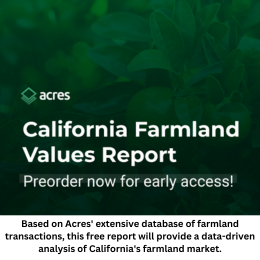October 21, 2021
By Lynda Kiernan-Stone, Global AgInvesting Media
On behalf of the Australian government, the Clean Energy Finance Fund (CEFC) has committed a cornerstone investment of A$50 million, (US$37.6 million) alongside another A$50 million (US$37.6 million) investment made by the ag impact investor, Kempen SDG Farmland Fund, in the Transforming Farming Platform – a newly launched sustainable farming initiative to be managed by Gunn Agri.
The platform will include mixed farming assets spanning the major cropping regions of Australia, focusing on capital investments in underperforming small-to-medium sized farms with the goal of lifting productivity and the optimization of land use.
To do this, this science-led initiative will avail itself of expert advice from leading agronomists and environmental advisors, including Australia’s CSIRO, to facilitate the adoption of data-driven practices such as regenerative farming methods and the latest land management.
Leveraging data from the CSIRO, including data from their Yield Gap research, the platform will examine cropping systems, crop variabilities, and weather and soil data to transform farms into productive and resilient operations with improved yields, reduced carbon emissions, and with the ability to sequester carbon.
Brad Wheaton, portfolio manager, Gunn Agri, noted that this integration of agricultural and environmental management practices to generate market-linked returns “is at the frontier of institutional investing in Australian agriculture”.
Ian Learmonth, CEO, CEFC, added, “Across Australia, farmers are looking to the latest technology to help them farm more productively and sustainably. We are delighted to support the broader use of research from groups such as the CSIRO to deliver energy efficiency improvements to farms as well as optimize production, soil carbon, biodiversity and other environmental outcomes.”
This regenerative farming platform also has the potential to general Australian Carbon Credit Units for soil and biomass carbon sequestration, which will meet the need for the verifiable quantification of climate and sustainable objectives for emission reduction projects.
Wheaton said, “As agricultural asset managers for institutions there is complete transparency in our financial performance. What is ground-breaking here is that we have embedded the same accountability in the delivery of soil carbon, carbon in vegetation, emission reduction, biodiversity and other sustainability measures.”
He continued, “The CEFC asked if we could target certain carbon emission and sequestration outcomes and ensure we could deliver on them. We developed a comprehensive set of indicators that track our performance, and we baseline and report against these with independent assurance of the whole framework.”
By now, we all are aware of the heavy demands that will be placed on the global food production system in order to feed the world population in the coming decades. The CSIRO predicts that this future security depends, in part, on achieving the highest possible yields on our existing farmland base.
This improved efficiency, combined with stronger resilience to the impacts of climate change, will help Australia’s farmers to meet the growing demand for the country’s agricultural products.
Furthermore, by employing sustainable and regenerative production from inception, the platform will be able to gather valuable data demonstrating the link between these practices , soil carbon, and farmland productivity.
The CEFC is not new to agricultural investment, having committed more than $500 million to both small and large projects including soil carbon initiatives – one of the five priorities noted in the Technology Investment Roadmap Low Emissions Technology Statement.
One such project was in partnership with Macquarie Infrastructure and Real Assets, working with the CSIRO on the development of FarmPrint – a novel tool to enable Australian farmers to monitor, benchmark, and evaluate their on-farm carbon footprint.
– Lynda Kiernan-Stone is editor with GAI Media, and is managing editor and daily contributor for Global AgInvesting’s AgInvesting Weekly News and Agtech Intel News, as well as HighQuest Group’s Oilseed & Grain News. She can be reached at lkiernan-stone@

Let GAI News inform your engagement in the agriculture sector.
GAI News provides crucial and timely news and insight to help you stay ahead of critical agricultural trends through free delivery of two weekly newsletters, Ag Investing Weekly and AgTech Intel.




